Detailed Business Analysis Report: M&S PLC Performance
VerifiedAdded on 2022/10/15
|11
|3481
|10
Report
AI Summary
This report provides an in-depth analysis of Mark & Spencer (M&S) PLC, a prominent British retailer. The report begins with an introduction to M&S, its history, organizational structure (including its flat structure), mission, vision, and governance. It then delves into the importance of PESTEL analysis for businesses. The core of the report is a PESTEL analysis of M&S, examining the political, economic, social, technological, environmental, and legal factors affecting the company. Each factor is discussed in detail, highlighting its potential impact on M&S's operations and strategic planning. The report emphasizes the importance of considering these external factors for business growth and success, particularly in the retail industry. The report concludes with a summary of the key findings and their implications for M&S.
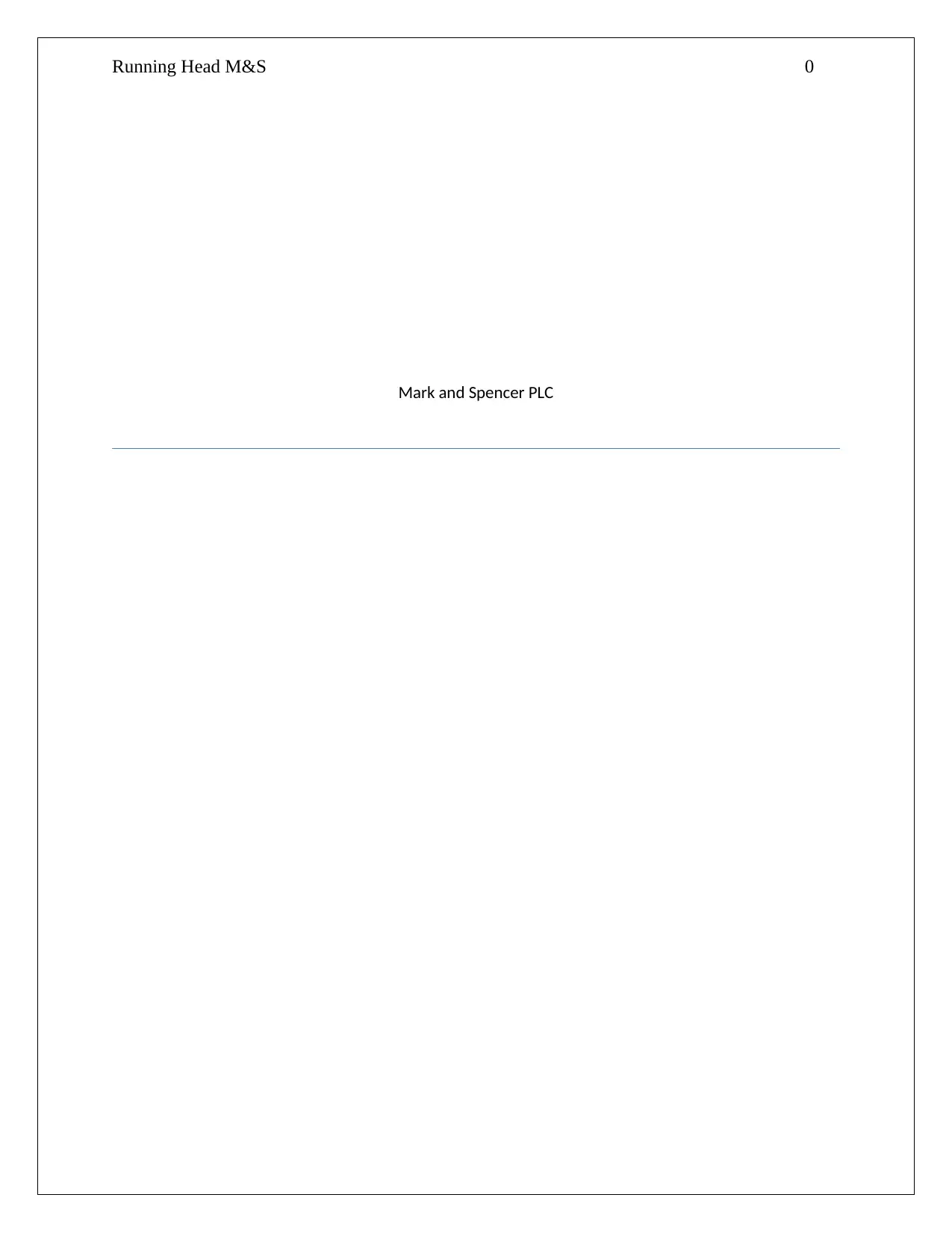
Running Head M&S 0
Mark and Spencer PLC
Mark and Spencer PLC
Paraphrase This Document
Need a fresh take? Get an instant paraphrase of this document with our AI Paraphraser
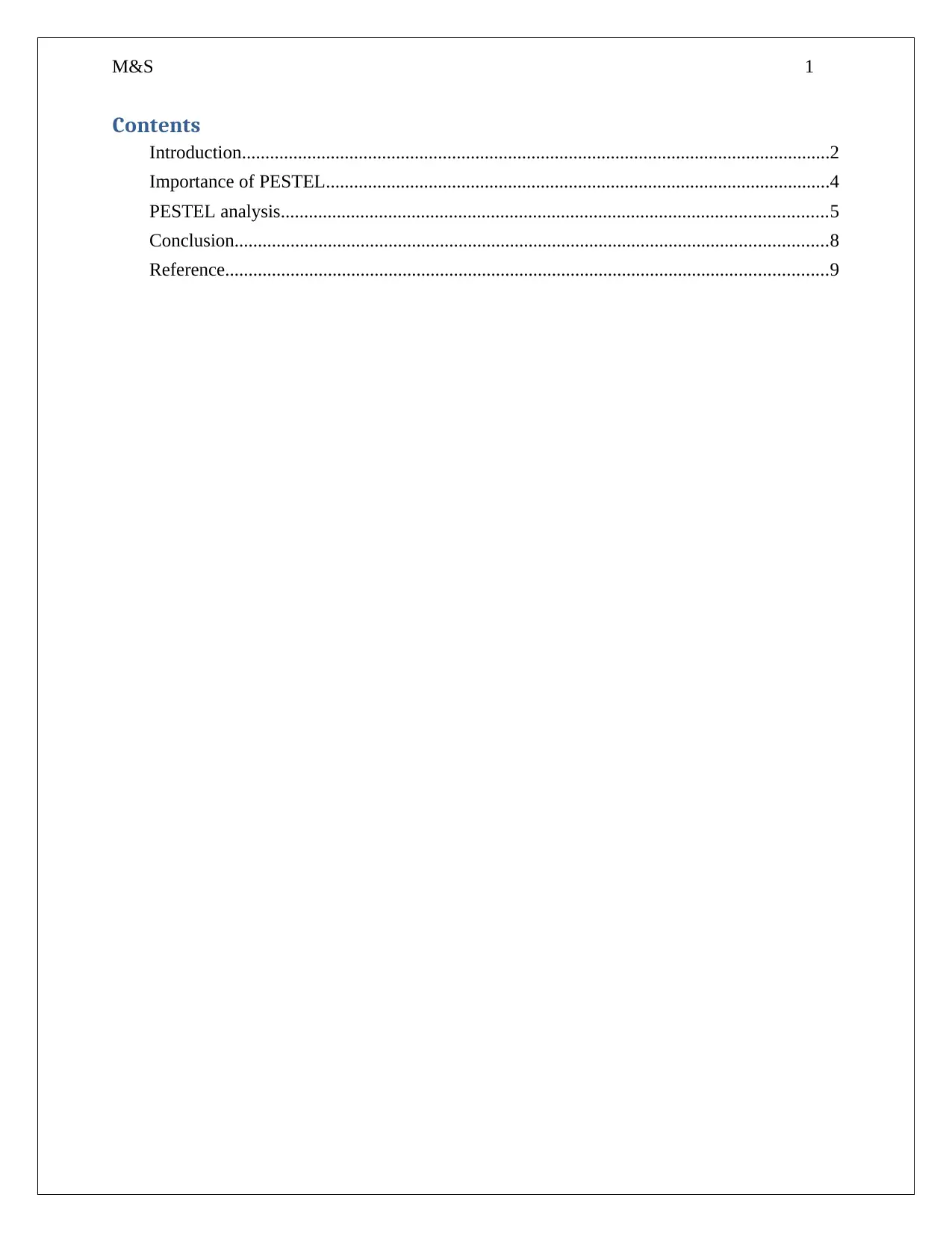
M&S 1
Contents
Introduction..............................................................................................................................2
Importance of PESTEL............................................................................................................4
PESTEL analysis.....................................................................................................................5
Conclusion...............................................................................................................................8
Reference.................................................................................................................................9
Contents
Introduction..............................................................................................................................2
Importance of PESTEL............................................................................................................4
PESTEL analysis.....................................................................................................................5
Conclusion...............................................................................................................................8
Reference.................................................................................................................................9
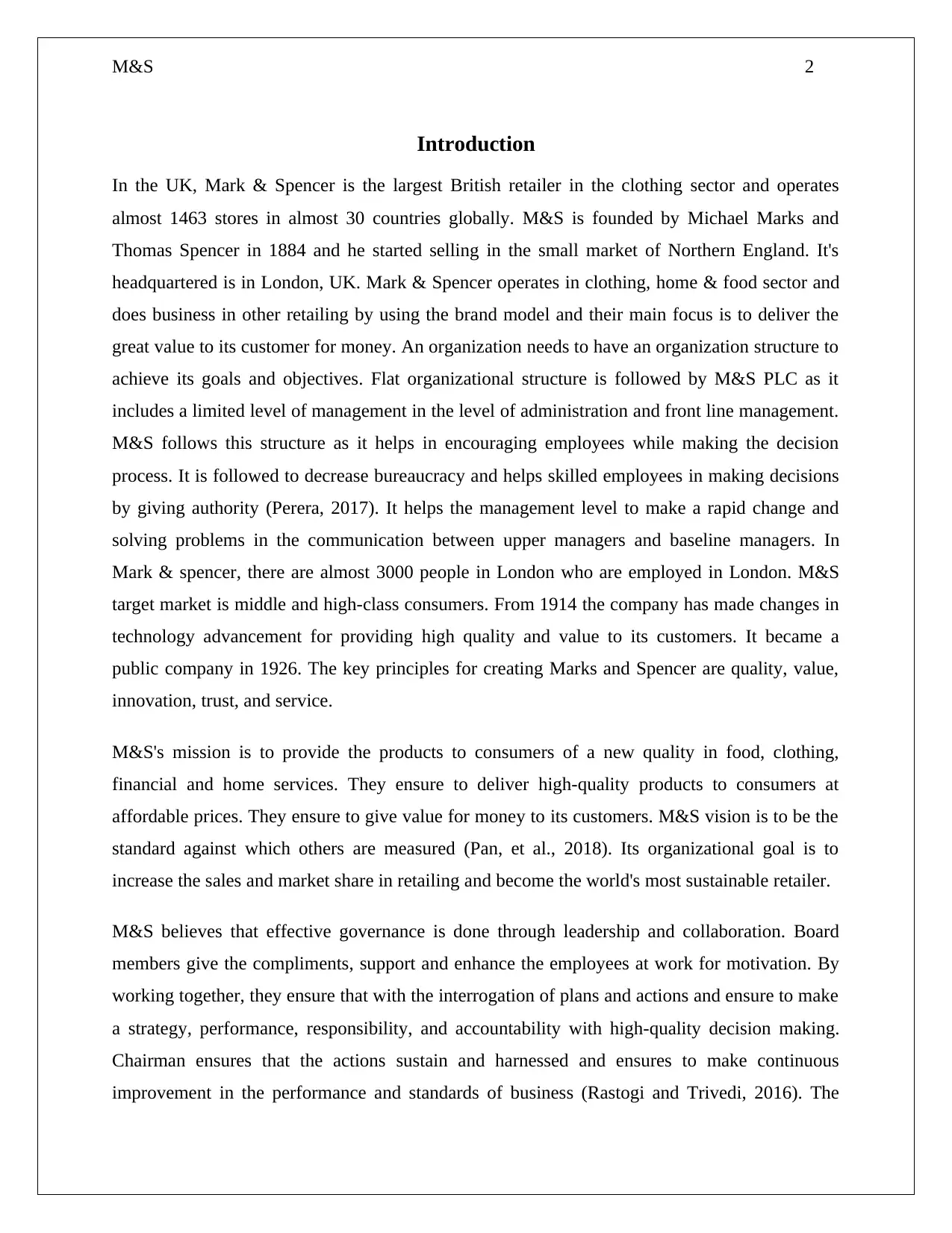
M&S 2
Introduction
In the UK, Mark & Spencer is the largest British retailer in the clothing sector and operates
almost 1463 stores in almost 30 countries globally. M&S is founded by Michael Marks and
Thomas Spencer in 1884 and he started selling in the small market of Northern England. It's
headquartered is in London, UK. Mark & Spencer operates in clothing, home & food sector and
does business in other retailing by using the brand model and their main focus is to deliver the
great value to its customer for money. An organization needs to have an organization structure to
achieve its goals and objectives. Flat organizational structure is followed by M&S PLC as it
includes a limited level of management in the level of administration and front line management.
M&S follows this structure as it helps in encouraging employees while making the decision
process. It is followed to decrease bureaucracy and helps skilled employees in making decisions
by giving authority (Perera, 2017). It helps the management level to make a rapid change and
solving problems in the communication between upper managers and baseline managers. In
Mark & spencer, there are almost 3000 people in London who are employed in London. M&S
target market is middle and high-class consumers. From 1914 the company has made changes in
technology advancement for providing high quality and value to its customers. It became a
public company in 1926. The key principles for creating Marks and Spencer are quality, value,
innovation, trust, and service.
M&S's mission is to provide the products to consumers of a new quality in food, clothing,
financial and home services. They ensure to deliver high-quality products to consumers at
affordable prices. They ensure to give value for money to its customers. M&S vision is to be the
standard against which others are measured (Pan, et al., 2018). Its organizational goal is to
increase the sales and market share in retailing and become the world's most sustainable retailer.
M&S believes that effective governance is done through leadership and collaboration. Board
members give the compliments, support and enhance the employees at work for motivation. By
working together, they ensure that with the interrogation of plans and actions and ensure to make
a strategy, performance, responsibility, and accountability with high-quality decision making.
Chairman ensures that the actions sustain and harnessed and ensures to make continuous
improvement in the performance and standards of business (Rastogi and Trivedi, 2016). The
Introduction
In the UK, Mark & Spencer is the largest British retailer in the clothing sector and operates
almost 1463 stores in almost 30 countries globally. M&S is founded by Michael Marks and
Thomas Spencer in 1884 and he started selling in the small market of Northern England. It's
headquartered is in London, UK. Mark & Spencer operates in clothing, home & food sector and
does business in other retailing by using the brand model and their main focus is to deliver the
great value to its customer for money. An organization needs to have an organization structure to
achieve its goals and objectives. Flat organizational structure is followed by M&S PLC as it
includes a limited level of management in the level of administration and front line management.
M&S follows this structure as it helps in encouraging employees while making the decision
process. It is followed to decrease bureaucracy and helps skilled employees in making decisions
by giving authority (Perera, 2017). It helps the management level to make a rapid change and
solving problems in the communication between upper managers and baseline managers. In
Mark & spencer, there are almost 3000 people in London who are employed in London. M&S
target market is middle and high-class consumers. From 1914 the company has made changes in
technology advancement for providing high quality and value to its customers. It became a
public company in 1926. The key principles for creating Marks and Spencer are quality, value,
innovation, trust, and service.
M&S's mission is to provide the products to consumers of a new quality in food, clothing,
financial and home services. They ensure to deliver high-quality products to consumers at
affordable prices. They ensure to give value for money to its customers. M&S vision is to be the
standard against which others are measured (Pan, et al., 2018). Its organizational goal is to
increase the sales and market share in retailing and become the world's most sustainable retailer.
M&S believes that effective governance is done through leadership and collaboration. Board
members give the compliments, support and enhance the employees at work for motivation. By
working together, they ensure that with the interrogation of plans and actions and ensure to make
a strategy, performance, responsibility, and accountability with high-quality decision making.
Chairman ensures that the actions sustain and harnessed and ensures to make continuous
improvement in the performance and standards of business (Rastogi and Trivedi, 2016). The
⊘ This is a preview!⊘
Do you want full access?
Subscribe today to unlock all pages.

Trusted by 1+ million students worldwide
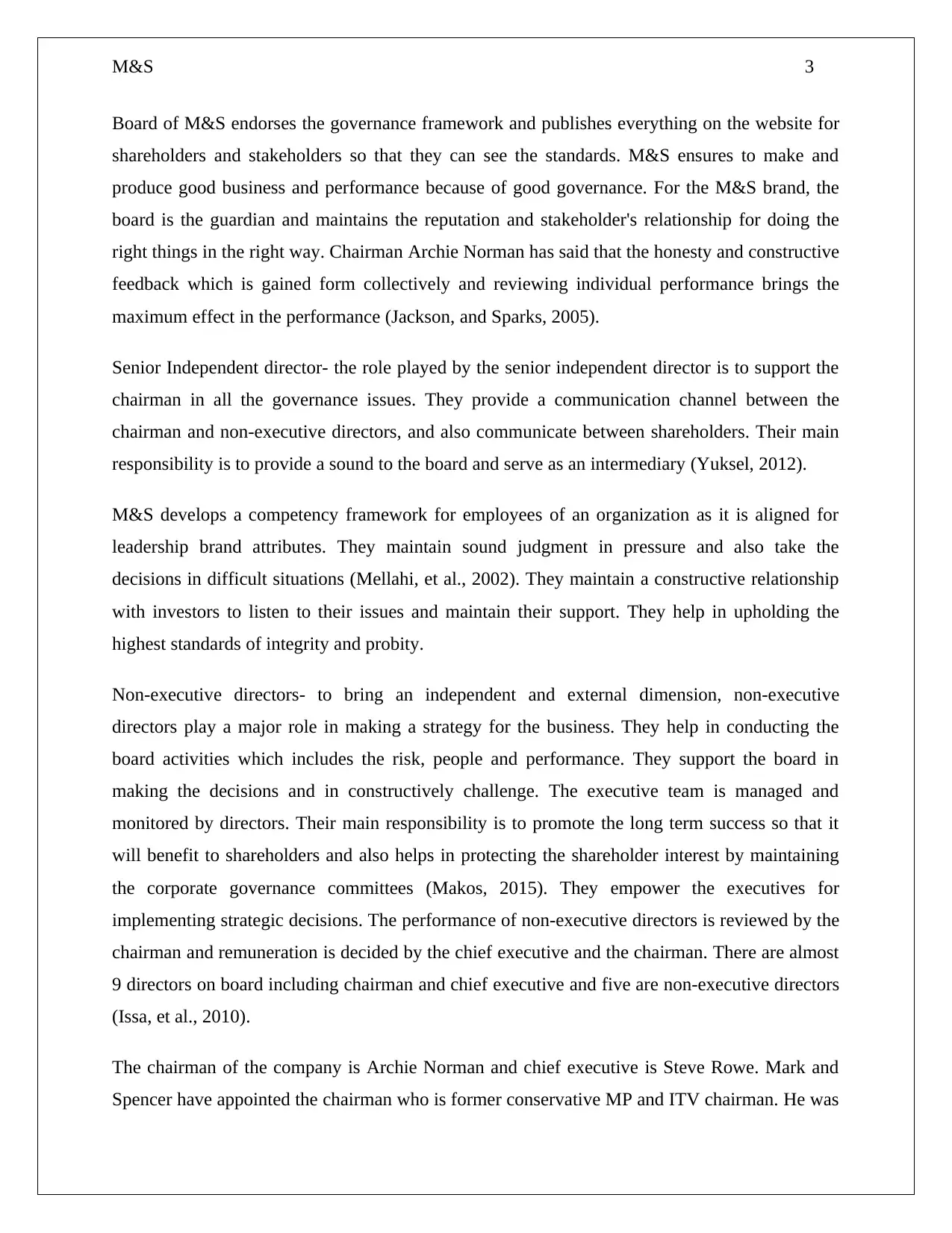
M&S 3
Board of M&S endorses the governance framework and publishes everything on the website for
shareholders and stakeholders so that they can see the standards. M&S ensures to make and
produce good business and performance because of good governance. For the M&S brand, the
board is the guardian and maintains the reputation and stakeholder's relationship for doing the
right things in the right way. Chairman Archie Norman has said that the honesty and constructive
feedback which is gained form collectively and reviewing individual performance brings the
maximum effect in the performance (Jackson, and Sparks, 2005).
Senior Independent director- the role played by the senior independent director is to support the
chairman in all the governance issues. They provide a communication channel between the
chairman and non-executive directors, and also communicate between shareholders. Their main
responsibility is to provide a sound to the board and serve as an intermediary (Yuksel, 2012).
M&S develops a competency framework for employees of an organization as it is aligned for
leadership brand attributes. They maintain sound judgment in pressure and also take the
decisions in difficult situations (Mellahi, et al., 2002). They maintain a constructive relationship
with investors to listen to their issues and maintain their support. They help in upholding the
highest standards of integrity and probity.
Non-executive directors- to bring an independent and external dimension, non-executive
directors play a major role in making a strategy for the business. They help in conducting the
board activities which includes the risk, people and performance. They support the board in
making the decisions and in constructively challenge. The executive team is managed and
monitored by directors. Their main responsibility is to promote the long term success so that it
will benefit to shareholders and also helps in protecting the shareholder interest by maintaining
the corporate governance committees (Makos, 2015). They empower the executives for
implementing strategic decisions. The performance of non-executive directors is reviewed by the
chairman and remuneration is decided by the chief executive and the chairman. There are almost
9 directors on board including chairman and chief executive and five are non-executive directors
(Issa, et al., 2010).
The chairman of the company is Archie Norman and chief executive is Steve Rowe. Mark and
Spencer have appointed the chairman who is former conservative MP and ITV chairman. He was
Board of M&S endorses the governance framework and publishes everything on the website for
shareholders and stakeholders so that they can see the standards. M&S ensures to make and
produce good business and performance because of good governance. For the M&S brand, the
board is the guardian and maintains the reputation and stakeholder's relationship for doing the
right things in the right way. Chairman Archie Norman has said that the honesty and constructive
feedback which is gained form collectively and reviewing individual performance brings the
maximum effect in the performance (Jackson, and Sparks, 2005).
Senior Independent director- the role played by the senior independent director is to support the
chairman in all the governance issues. They provide a communication channel between the
chairman and non-executive directors, and also communicate between shareholders. Their main
responsibility is to provide a sound to the board and serve as an intermediary (Yuksel, 2012).
M&S develops a competency framework for employees of an organization as it is aligned for
leadership brand attributes. They maintain sound judgment in pressure and also take the
decisions in difficult situations (Mellahi, et al., 2002). They maintain a constructive relationship
with investors to listen to their issues and maintain their support. They help in upholding the
highest standards of integrity and probity.
Non-executive directors- to bring an independent and external dimension, non-executive
directors play a major role in making a strategy for the business. They help in conducting the
board activities which includes the risk, people and performance. They support the board in
making the decisions and in constructively challenge. The executive team is managed and
monitored by directors. Their main responsibility is to promote the long term success so that it
will benefit to shareholders and also helps in protecting the shareholder interest by maintaining
the corporate governance committees (Makos, 2015). They empower the executives for
implementing strategic decisions. The performance of non-executive directors is reviewed by the
chairman and remuneration is decided by the chief executive and the chairman. There are almost
9 directors on board including chairman and chief executive and five are non-executive directors
(Issa, et al., 2010).
The chairman of the company is Archie Norman and chief executive is Steve Rowe. Mark and
Spencer have appointed the chairman who is former conservative MP and ITV chairman. He was
Paraphrase This Document
Need a fresh take? Get an instant paraphrase of this document with our AI Paraphraser
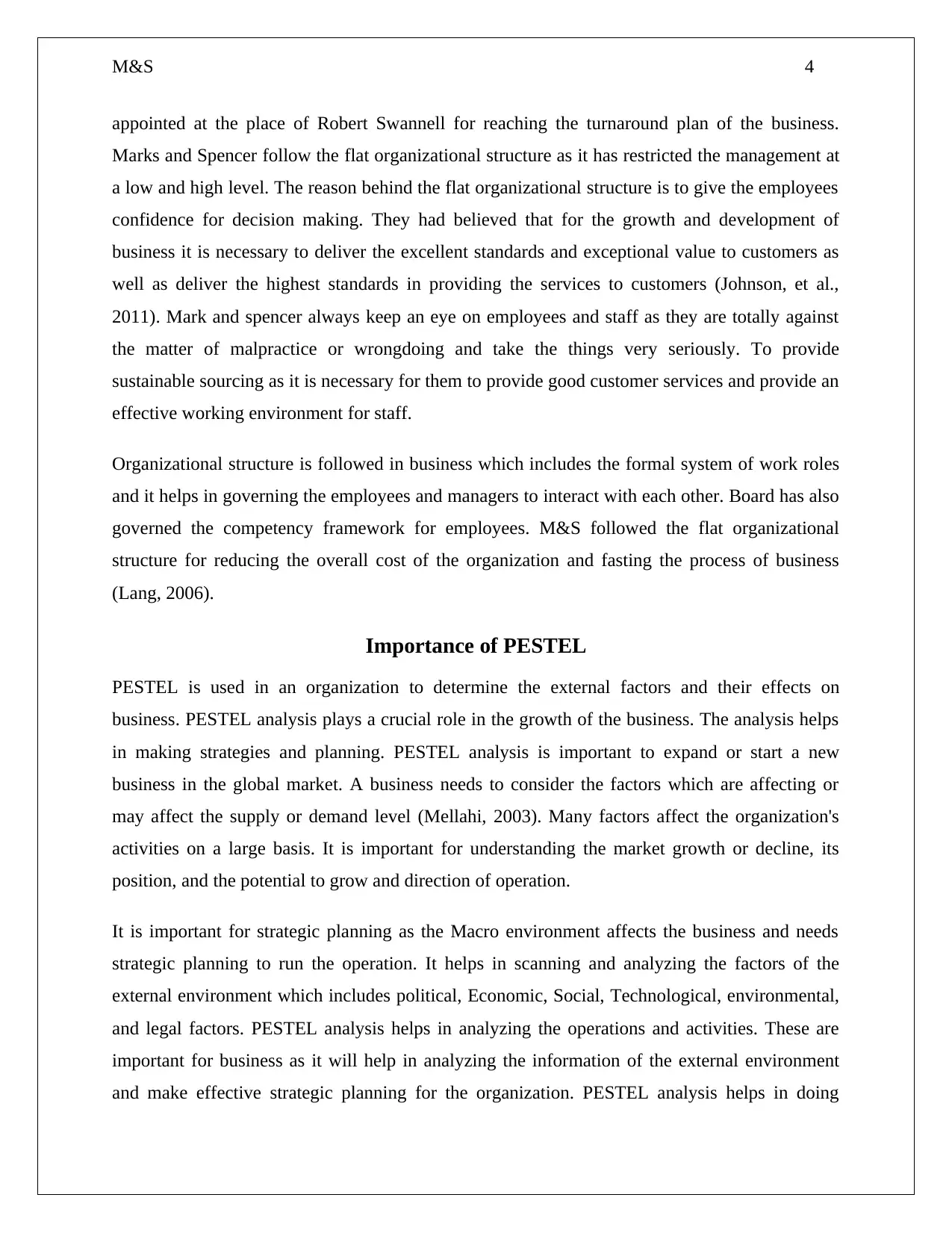
M&S 4
appointed at the place of Robert Swannell for reaching the turnaround plan of the business.
Marks and Spencer follow the flat organizational structure as it has restricted the management at
a low and high level. The reason behind the flat organizational structure is to give the employees
confidence for decision making. They had believed that for the growth and development of
business it is necessary to deliver the excellent standards and exceptional value to customers as
well as deliver the highest standards in providing the services to customers (Johnson, et al.,
2011). Mark and spencer always keep an eye on employees and staff as they are totally against
the matter of malpractice or wrongdoing and take the things very seriously. To provide
sustainable sourcing as it is necessary for them to provide good customer services and provide an
effective working environment for staff.
Organizational structure is followed in business which includes the formal system of work roles
and it helps in governing the employees and managers to interact with each other. Board has also
governed the competency framework for employees. M&S followed the flat organizational
structure for reducing the overall cost of the organization and fasting the process of business
(Lang, 2006).
Importance of PESTEL
PESTEL is used in an organization to determine the external factors and their effects on
business. PESTEL analysis plays a crucial role in the growth of the business. The analysis helps
in making strategies and planning. PESTEL analysis is important to expand or start a new
business in the global market. A business needs to consider the factors which are affecting or
may affect the supply or demand level (Mellahi, 2003). Many factors affect the organization's
activities on a large basis. It is important for understanding the market growth or decline, its
position, and the potential to grow and direction of operation.
It is important for strategic planning as the Macro environment affects the business and needs
strategic planning to run the operation. It helps in scanning and analyzing the factors of the
external environment which includes political, Economic, Social, Technological, environmental,
and legal factors. PESTEL analysis helps in analyzing the operations and activities. These are
important for business as it will help in analyzing the information of the external environment
and make effective strategic planning for the organization. PESTEL analysis helps in doing
appointed at the place of Robert Swannell for reaching the turnaround plan of the business.
Marks and Spencer follow the flat organizational structure as it has restricted the management at
a low and high level. The reason behind the flat organizational structure is to give the employees
confidence for decision making. They had believed that for the growth and development of
business it is necessary to deliver the excellent standards and exceptional value to customers as
well as deliver the highest standards in providing the services to customers (Johnson, et al.,
2011). Mark and spencer always keep an eye on employees and staff as they are totally against
the matter of malpractice or wrongdoing and take the things very seriously. To provide
sustainable sourcing as it is necessary for them to provide good customer services and provide an
effective working environment for staff.
Organizational structure is followed in business which includes the formal system of work roles
and it helps in governing the employees and managers to interact with each other. Board has also
governed the competency framework for employees. M&S followed the flat organizational
structure for reducing the overall cost of the organization and fasting the process of business
(Lang, 2006).
Importance of PESTEL
PESTEL is used in an organization to determine the external factors and their effects on
business. PESTEL analysis plays a crucial role in the growth of the business. The analysis helps
in making strategies and planning. PESTEL analysis is important to expand or start a new
business in the global market. A business needs to consider the factors which are affecting or
may affect the supply or demand level (Mellahi, 2003). Many factors affect the organization's
activities on a large basis. It is important for understanding the market growth or decline, its
position, and the potential to grow and direction of operation.
It is important for strategic planning as the Macro environment affects the business and needs
strategic planning to run the operation. It helps in scanning and analyzing the factors of the
external environment which includes political, Economic, Social, Technological, environmental,
and legal factors. PESTEL analysis helps in analyzing the operations and activities. These are
important for business as it will help in analyzing the information of the external environment
and make effective strategic planning for the organization. PESTEL analysis helps in doing
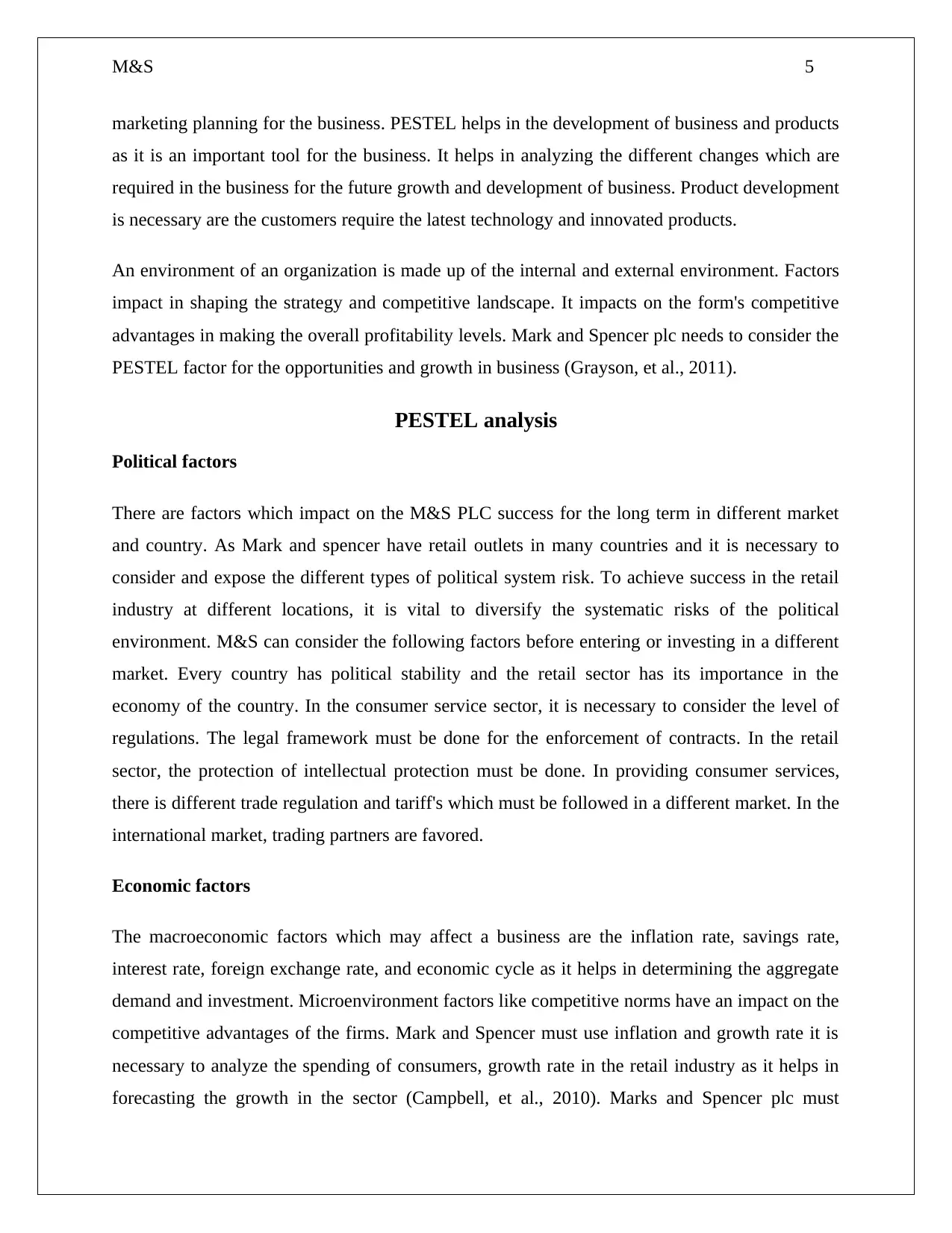
M&S 5
marketing planning for the business. PESTEL helps in the development of business and products
as it is an important tool for the business. It helps in analyzing the different changes which are
required in the business for the future growth and development of business. Product development
is necessary are the customers require the latest technology and innovated products.
An environment of an organization is made up of the internal and external environment. Factors
impact in shaping the strategy and competitive landscape. It impacts on the form's competitive
advantages in making the overall profitability levels. Mark and Spencer plc needs to consider the
PESTEL factor for the opportunities and growth in business (Grayson, et al., 2011).
PESTEL analysis
Political factors
There are factors which impact on the M&S PLC success for the long term in different market
and country. As Mark and spencer have retail outlets in many countries and it is necessary to
consider and expose the different types of political system risk. To achieve success in the retail
industry at different locations, it is vital to diversify the systematic risks of the political
environment. M&S can consider the following factors before entering or investing in a different
market. Every country has political stability and the retail sector has its importance in the
economy of the country. In the consumer service sector, it is necessary to consider the level of
regulations. The legal framework must be done for the enforcement of contracts. In the retail
sector, the protection of intellectual protection must be done. In providing consumer services,
there is different trade regulation and tariff's which must be followed in a different market. In the
international market, trading partners are favored.
Economic factors
The macroeconomic factors which may affect a business are the inflation rate, savings rate,
interest rate, foreign exchange rate, and economic cycle as it helps in determining the aggregate
demand and investment. Microenvironment factors like competitive norms have an impact on the
competitive advantages of the firms. Mark and Spencer must use inflation and growth rate it is
necessary to analyze the spending of consumers, growth rate in the retail industry as it helps in
forecasting the growth in the sector (Campbell, et al., 2010). Marks and Spencer plc must
marketing planning for the business. PESTEL helps in the development of business and products
as it is an important tool for the business. It helps in analyzing the different changes which are
required in the business for the future growth and development of business. Product development
is necessary are the customers require the latest technology and innovated products.
An environment of an organization is made up of the internal and external environment. Factors
impact in shaping the strategy and competitive landscape. It impacts on the form's competitive
advantages in making the overall profitability levels. Mark and Spencer plc needs to consider the
PESTEL factor for the opportunities and growth in business (Grayson, et al., 2011).
PESTEL analysis
Political factors
There are factors which impact on the M&S PLC success for the long term in different market
and country. As Mark and spencer have retail outlets in many countries and it is necessary to
consider and expose the different types of political system risk. To achieve success in the retail
industry at different locations, it is vital to diversify the systematic risks of the political
environment. M&S can consider the following factors before entering or investing in a different
market. Every country has political stability and the retail sector has its importance in the
economy of the country. In the consumer service sector, it is necessary to consider the level of
regulations. The legal framework must be done for the enforcement of contracts. In the retail
sector, the protection of intellectual protection must be done. In providing consumer services,
there is different trade regulation and tariff's which must be followed in a different market. In the
international market, trading partners are favored.
Economic factors
The macroeconomic factors which may affect a business are the inflation rate, savings rate,
interest rate, foreign exchange rate, and economic cycle as it helps in determining the aggregate
demand and investment. Microenvironment factors like competitive norms have an impact on the
competitive advantages of the firms. Mark and Spencer must use inflation and growth rate it is
necessary to analyze the spending of consumers, growth rate in the retail industry as it helps in
forecasting the growth in the sector (Campbell, et al., 2010). Marks and Spencer plc must
⊘ This is a preview!⊘
Do you want full access?
Subscribe today to unlock all pages.

Trusted by 1+ million students worldwide
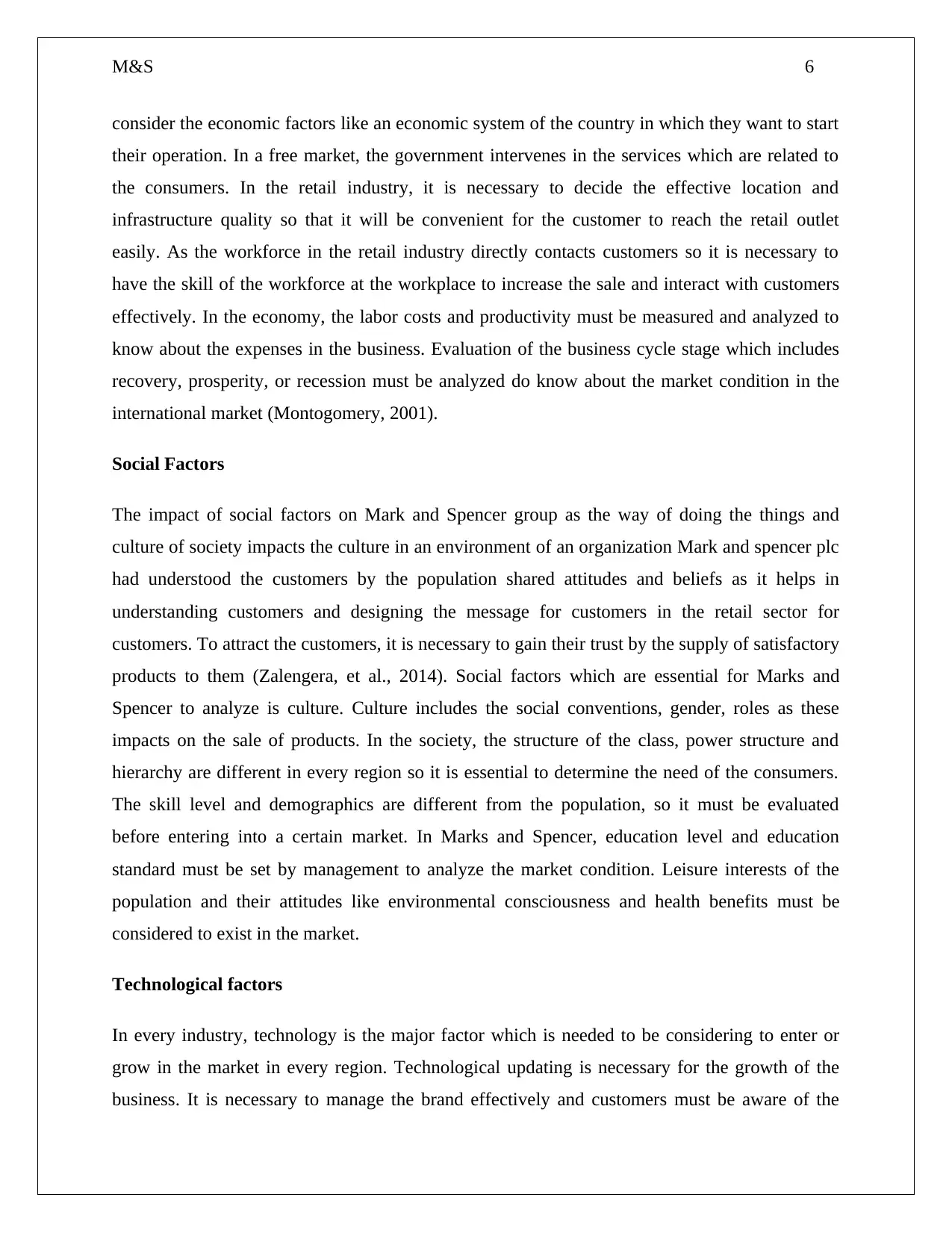
M&S 6
consider the economic factors like an economic system of the country in which they want to start
their operation. In a free market, the government intervenes in the services which are related to
the consumers. In the retail industry, it is necessary to decide the effective location and
infrastructure quality so that it will be convenient for the customer to reach the retail outlet
easily. As the workforce in the retail industry directly contacts customers so it is necessary to
have the skill of the workforce at the workplace to increase the sale and interact with customers
effectively. In the economy, the labor costs and productivity must be measured and analyzed to
know about the expenses in the business. Evaluation of the business cycle stage which includes
recovery, prosperity, or recession must be analyzed do know about the market condition in the
international market (Montogomery, 2001).
Social Factors
The impact of social factors on Mark and Spencer group as the way of doing the things and
culture of society impacts the culture in an environment of an organization Mark and spencer plc
had understood the customers by the population shared attitudes and beliefs as it helps in
understanding customers and designing the message for customers in the retail sector for
customers. To attract the customers, it is necessary to gain their trust by the supply of satisfactory
products to them (Zalengera, et al., 2014). Social factors which are essential for Marks and
Spencer to analyze is culture. Culture includes the social conventions, gender, roles as these
impacts on the sale of products. In the society, the structure of the class, power structure and
hierarchy are different in every region so it is essential to determine the need of the consumers.
The skill level and demographics are different from the population, so it must be evaluated
before entering into a certain market. In Marks and Spencer, education level and education
standard must be set by management to analyze the market condition. Leisure interests of the
population and their attitudes like environmental consciousness and health benefits must be
considered to exist in the market.
Technological factors
In every industry, technology is the major factor which is needed to be considering to enter or
grow in the market in every region. Technological updating is necessary for the growth of the
business. It is necessary to manage the brand effectively and customers must be aware of the
consider the economic factors like an economic system of the country in which they want to start
their operation. In a free market, the government intervenes in the services which are related to
the consumers. In the retail industry, it is necessary to decide the effective location and
infrastructure quality so that it will be convenient for the customer to reach the retail outlet
easily. As the workforce in the retail industry directly contacts customers so it is necessary to
have the skill of the workforce at the workplace to increase the sale and interact with customers
effectively. In the economy, the labor costs and productivity must be measured and analyzed to
know about the expenses in the business. Evaluation of the business cycle stage which includes
recovery, prosperity, or recession must be analyzed do know about the market condition in the
international market (Montogomery, 2001).
Social Factors
The impact of social factors on Mark and Spencer group as the way of doing the things and
culture of society impacts the culture in an environment of an organization Mark and spencer plc
had understood the customers by the population shared attitudes and beliefs as it helps in
understanding customers and designing the message for customers in the retail sector for
customers. To attract the customers, it is necessary to gain their trust by the supply of satisfactory
products to them (Zalengera, et al., 2014). Social factors which are essential for Marks and
Spencer to analyze is culture. Culture includes the social conventions, gender, roles as these
impacts on the sale of products. In the society, the structure of the class, power structure and
hierarchy are different in every region so it is essential to determine the need of the consumers.
The skill level and demographics are different from the population, so it must be evaluated
before entering into a certain market. In Marks and Spencer, education level and education
standard must be set by management to analyze the market condition. Leisure interests of the
population and their attitudes like environmental consciousness and health benefits must be
considered to exist in the market.
Technological factors
In every industry, technology is the major factor which is needed to be considering to enter or
grow in the market in every region. Technological updating is necessary for the growth of the
business. It is necessary to manage the brand effectively and customers must be aware of the
Paraphrase This Document
Need a fresh take? Get an instant paraphrase of this document with our AI Paraphraser
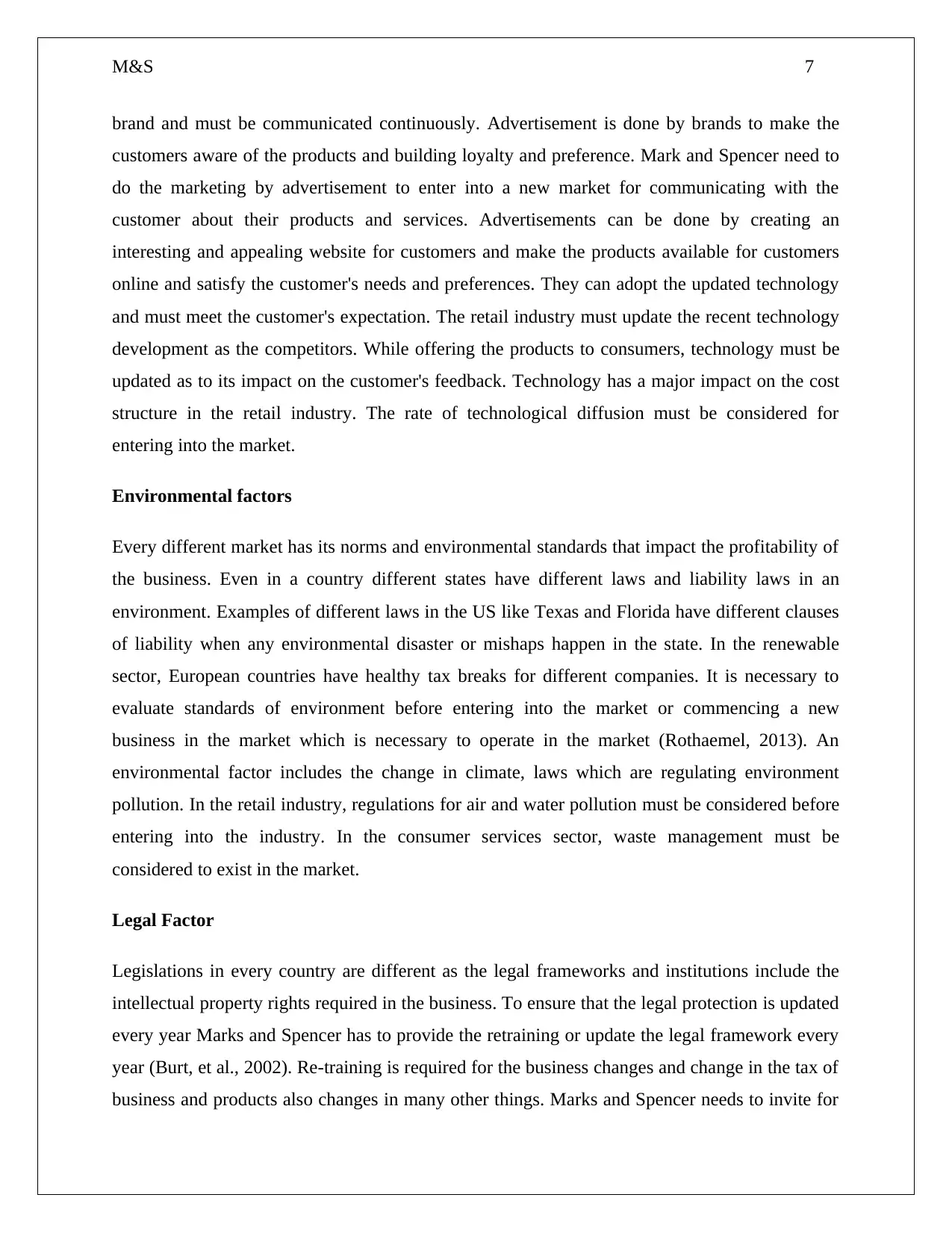
M&S 7
brand and must be communicated continuously. Advertisement is done by brands to make the
customers aware of the products and building loyalty and preference. Mark and Spencer need to
do the marketing by advertisement to enter into a new market for communicating with the
customer about their products and services. Advertisements can be done by creating an
interesting and appealing website for customers and make the products available for customers
online and satisfy the customer's needs and preferences. They can adopt the updated technology
and must meet the customer's expectation. The retail industry must update the recent technology
development as the competitors. While offering the products to consumers, technology must be
updated as to its impact on the customer's feedback. Technology has a major impact on the cost
structure in the retail industry. The rate of technological diffusion must be considered for
entering into the market.
Environmental factors
Every different market has its norms and environmental standards that impact the profitability of
the business. Even in a country different states have different laws and liability laws in an
environment. Examples of different laws in the US like Texas and Florida have different clauses
of liability when any environmental disaster or mishaps happen in the state. In the renewable
sector, European countries have healthy tax breaks for different companies. It is necessary to
evaluate standards of environment before entering into the market or commencing a new
business in the market which is necessary to operate in the market (Rothaemel, 2013). An
environmental factor includes the change in climate, laws which are regulating environment
pollution. In the retail industry, regulations for air and water pollution must be considered before
entering into the industry. In the consumer services sector, waste management must be
considered to exist in the market.
Legal Factor
Legislations in every country are different as the legal frameworks and institutions include the
intellectual property rights required in the business. To ensure that the legal protection is updated
every year Marks and Spencer has to provide the retraining or update the legal framework every
year (Burt, et al., 2002). Re-training is required for the business changes and change in the tax of
business and products also changes in many other things. Marks and Spencer needs to invite for
brand and must be communicated continuously. Advertisement is done by brands to make the
customers aware of the products and building loyalty and preference. Mark and Spencer need to
do the marketing by advertisement to enter into a new market for communicating with the
customer about their products and services. Advertisements can be done by creating an
interesting and appealing website for customers and make the products available for customers
online and satisfy the customer's needs and preferences. They can adopt the updated technology
and must meet the customer's expectation. The retail industry must update the recent technology
development as the competitors. While offering the products to consumers, technology must be
updated as to its impact on the customer's feedback. Technology has a major impact on the cost
structure in the retail industry. The rate of technological diffusion must be considered for
entering into the market.
Environmental factors
Every different market has its norms and environmental standards that impact the profitability of
the business. Even in a country different states have different laws and liability laws in an
environment. Examples of different laws in the US like Texas and Florida have different clauses
of liability when any environmental disaster or mishaps happen in the state. In the renewable
sector, European countries have healthy tax breaks for different companies. It is necessary to
evaluate standards of environment before entering into the market or commencing a new
business in the market which is necessary to operate in the market (Rothaemel, 2013). An
environmental factor includes the change in climate, laws which are regulating environment
pollution. In the retail industry, regulations for air and water pollution must be considered before
entering into the industry. In the consumer services sector, waste management must be
considered to exist in the market.
Legal Factor
Legislations in every country are different as the legal frameworks and institutions include the
intellectual property rights required in the business. To ensure that the legal protection is updated
every year Marks and Spencer has to provide the retraining or update the legal framework every
year (Burt, et al., 2002). Re-training is required for the business changes and change in the tax of
business and products also changes in many other things. Marks and Spencer needs to invite for
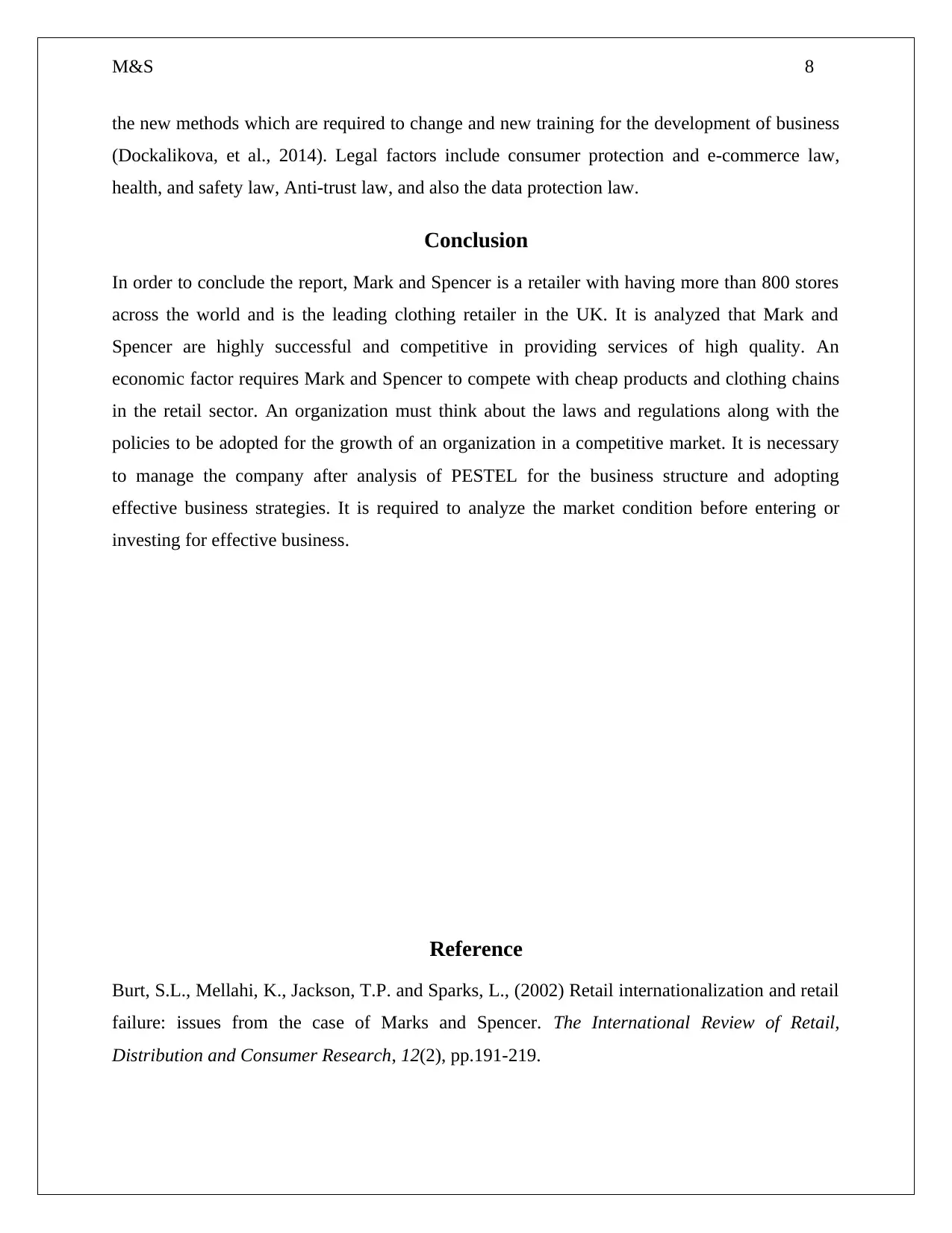
M&S 8
the new methods which are required to change and new training for the development of business
(Dockalikova, et al., 2014). Legal factors include consumer protection and e-commerce law,
health, and safety law, Anti-trust law, and also the data protection law.
Conclusion
In order to conclude the report, Mark and Spencer is a retailer with having more than 800 stores
across the world and is the leading clothing retailer in the UK. It is analyzed that Mark and
Spencer are highly successful and competitive in providing services of high quality. An
economic factor requires Mark and Spencer to compete with cheap products and clothing chains
in the retail sector. An organization must think about the laws and regulations along with the
policies to be adopted for the growth of an organization in a competitive market. It is necessary
to manage the company after analysis of PESTEL for the business structure and adopting
effective business strategies. It is required to analyze the market condition before entering or
investing for effective business.
Reference
Burt, S.L., Mellahi, K., Jackson, T.P. and Sparks, L., (2002) Retail internationalization and retail
failure: issues from the case of Marks and Spencer. The International Review of Retail,
Distribution and Consumer Research, 12(2), pp.191-219.
the new methods which are required to change and new training for the development of business
(Dockalikova, et al., 2014). Legal factors include consumer protection and e-commerce law,
health, and safety law, Anti-trust law, and also the data protection law.
Conclusion
In order to conclude the report, Mark and Spencer is a retailer with having more than 800 stores
across the world and is the leading clothing retailer in the UK. It is analyzed that Mark and
Spencer are highly successful and competitive in providing services of high quality. An
economic factor requires Mark and Spencer to compete with cheap products and clothing chains
in the retail sector. An organization must think about the laws and regulations along with the
policies to be adopted for the growth of an organization in a competitive market. It is necessary
to manage the company after analysis of PESTEL for the business structure and adopting
effective business strategies. It is required to analyze the market condition before entering or
investing for effective business.
Reference
Burt, S.L., Mellahi, K., Jackson, T.P. and Sparks, L., (2002) Retail internationalization and retail
failure: issues from the case of Marks and Spencer. The International Review of Retail,
Distribution and Consumer Research, 12(2), pp.191-219.
⊘ This is a preview!⊘
Do you want full access?
Subscribe today to unlock all pages.

Trusted by 1+ million students worldwide
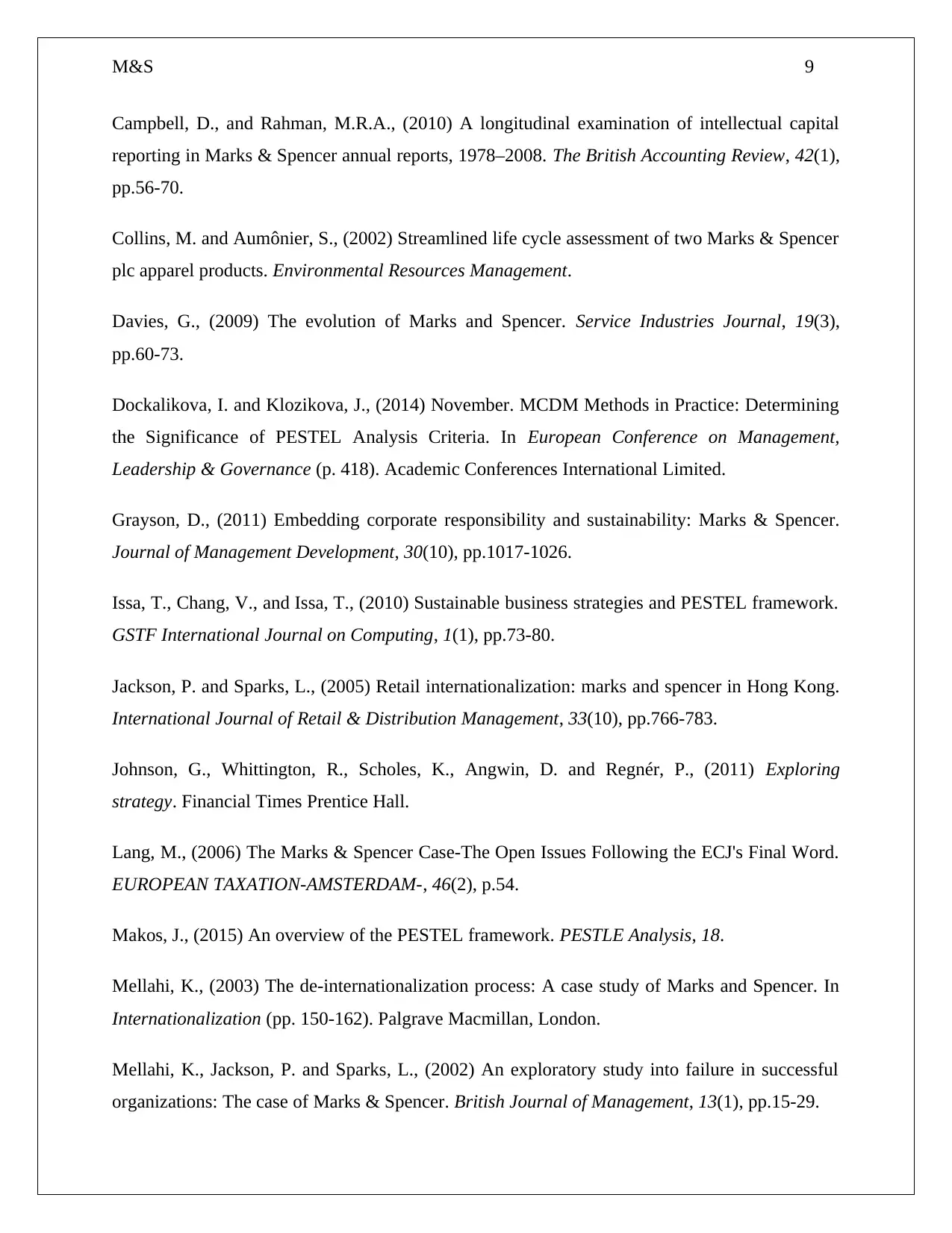
M&S 9
Campbell, D., and Rahman, M.R.A., (2010) A longitudinal examination of intellectual capital
reporting in Marks & Spencer annual reports, 1978–2008. The British Accounting Review, 42(1),
pp.56-70.
Collins, M. and Aumônier, S., (2002) Streamlined life cycle assessment of two Marks & Spencer
plc apparel products. Environmental Resources Management.
Davies, G., (2009) The evolution of Marks and Spencer. Service Industries Journal, 19(3),
pp.60-73.
Dockalikova, I. and Klozikova, J., (2014) November. MCDM Methods in Practice: Determining
the Significance of PESTEL Analysis Criteria. In European Conference on Management,
Leadership & Governance (p. 418). Academic Conferences International Limited.
Grayson, D., (2011) Embedding corporate responsibility and sustainability: Marks & Spencer.
Journal of Management Development, 30(10), pp.1017-1026.
Issa, T., Chang, V., and Issa, T., (2010) Sustainable business strategies and PESTEL framework.
GSTF International Journal on Computing, 1(1), pp.73-80.
Jackson, P. and Sparks, L., (2005) Retail internationalization: marks and spencer in Hong Kong.
International Journal of Retail & Distribution Management, 33(10), pp.766-783.
Johnson, G., Whittington, R., Scholes, K., Angwin, D. and Regnér, P., (2011) Exploring
strategy. Financial Times Prentice Hall.
Lang, M., (2006) The Marks & Spencer Case-The Open Issues Following the ECJ's Final Word.
EUROPEAN TAXATION-AMSTERDAM-, 46(2), p.54.
Makos, J., (2015) An overview of the PESTEL framework. PESTLE Analysis, 18.
Mellahi, K., (2003) The de-internationalization process: A case study of Marks and Spencer. In
Internationalization (pp. 150-162). Palgrave Macmillan, London.
Mellahi, K., Jackson, P. and Sparks, L., (2002) An exploratory study into failure in successful
organizations: The case of Marks & Spencer. British Journal of Management, 13(1), pp.15-29.
Campbell, D., and Rahman, M.R.A., (2010) A longitudinal examination of intellectual capital
reporting in Marks & Spencer annual reports, 1978–2008. The British Accounting Review, 42(1),
pp.56-70.
Collins, M. and Aumônier, S., (2002) Streamlined life cycle assessment of two Marks & Spencer
plc apparel products. Environmental Resources Management.
Davies, G., (2009) The evolution of Marks and Spencer. Service Industries Journal, 19(3),
pp.60-73.
Dockalikova, I. and Klozikova, J., (2014) November. MCDM Methods in Practice: Determining
the Significance of PESTEL Analysis Criteria. In European Conference on Management,
Leadership & Governance (p. 418). Academic Conferences International Limited.
Grayson, D., (2011) Embedding corporate responsibility and sustainability: Marks & Spencer.
Journal of Management Development, 30(10), pp.1017-1026.
Issa, T., Chang, V., and Issa, T., (2010) Sustainable business strategies and PESTEL framework.
GSTF International Journal on Computing, 1(1), pp.73-80.
Jackson, P. and Sparks, L., (2005) Retail internationalization: marks and spencer in Hong Kong.
International Journal of Retail & Distribution Management, 33(10), pp.766-783.
Johnson, G., Whittington, R., Scholes, K., Angwin, D. and Regnér, P., (2011) Exploring
strategy. Financial Times Prentice Hall.
Lang, M., (2006) The Marks & Spencer Case-The Open Issues Following the ECJ's Final Word.
EUROPEAN TAXATION-AMSTERDAM-, 46(2), p.54.
Makos, J., (2015) An overview of the PESTEL framework. PESTLE Analysis, 18.
Mellahi, K., (2003) The de-internationalization process: A case study of Marks and Spencer. In
Internationalization (pp. 150-162). Palgrave Macmillan, London.
Mellahi, K., Jackson, P. and Sparks, L., (2002) An exploratory study into failure in successful
organizations: The case of Marks & Spencer. British Journal of Management, 13(1), pp.15-29.
Paraphrase This Document
Need a fresh take? Get an instant paraphrase of this document with our AI Paraphraser
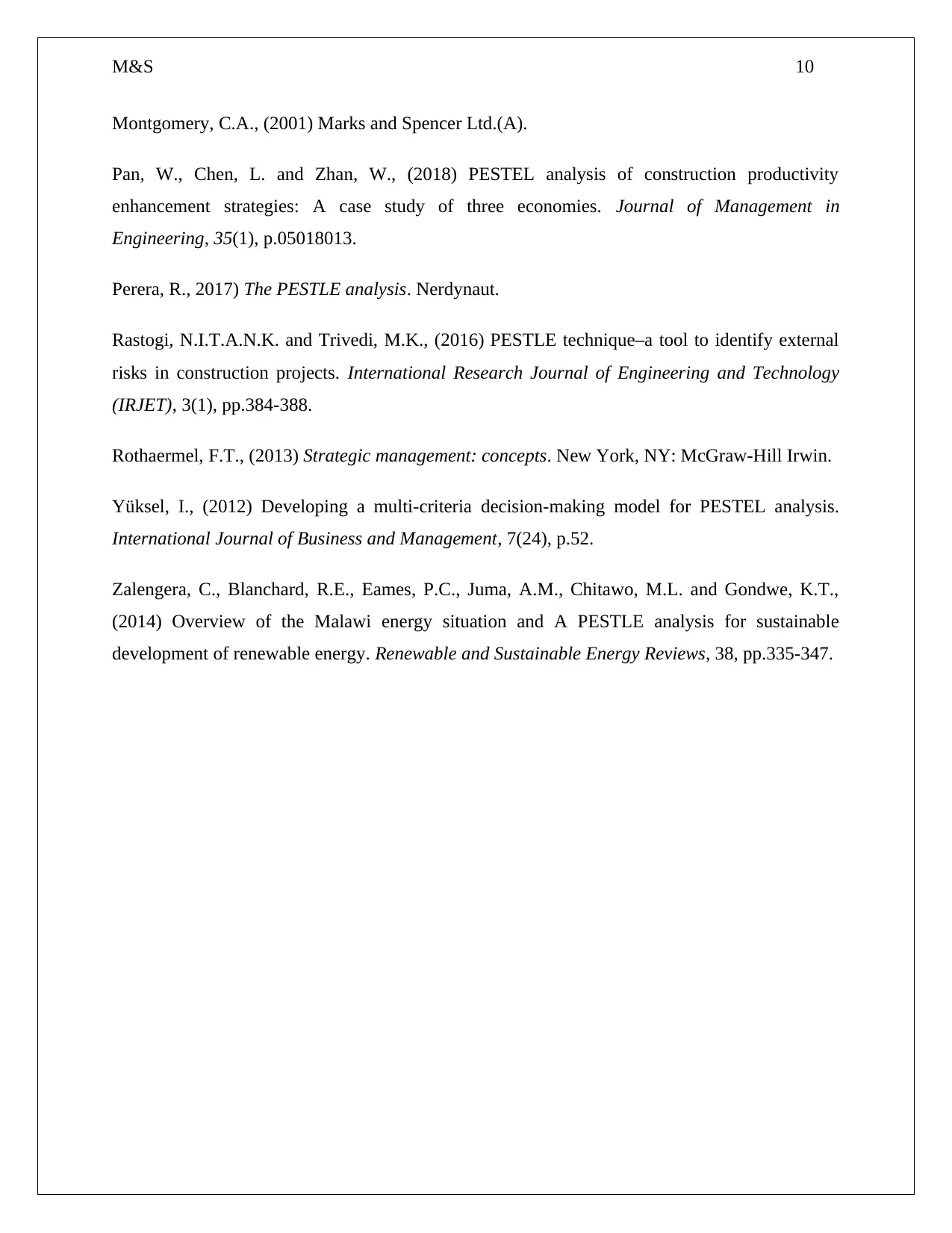
M&S 10
Montgomery, C.A., (2001) Marks and Spencer Ltd.(A).
Pan, W., Chen, L. and Zhan, W., (2018) PESTEL analysis of construction productivity
enhancement strategies: A case study of three economies. Journal of Management in
Engineering, 35(1), p.05018013.
Perera, R., 2017) The PESTLE analysis. Nerdynaut.
Rastogi, N.I.T.A.N.K. and Trivedi, M.K., (2016) PESTLE technique–a tool to identify external
risks in construction projects. International Research Journal of Engineering and Technology
(IRJET), 3(1), pp.384-388.
Rothaermel, F.T., (2013) Strategic management: concepts. New York, NY: McGraw-Hill Irwin.
Yüksel, I., (2012) Developing a multi-criteria decision-making model for PESTEL analysis.
International Journal of Business and Management, 7(24), p.52.
Zalengera, C., Blanchard, R.E., Eames, P.C., Juma, A.M., Chitawo, M.L. and Gondwe, K.T.,
(2014) Overview of the Malawi energy situation and A PESTLE analysis for sustainable
development of renewable energy. Renewable and Sustainable Energy Reviews, 38, pp.335-347.
Montgomery, C.A., (2001) Marks and Spencer Ltd.(A).
Pan, W., Chen, L. and Zhan, W., (2018) PESTEL analysis of construction productivity
enhancement strategies: A case study of three economies. Journal of Management in
Engineering, 35(1), p.05018013.
Perera, R., 2017) The PESTLE analysis. Nerdynaut.
Rastogi, N.I.T.A.N.K. and Trivedi, M.K., (2016) PESTLE technique–a tool to identify external
risks in construction projects. International Research Journal of Engineering and Technology
(IRJET), 3(1), pp.384-388.
Rothaermel, F.T., (2013) Strategic management: concepts. New York, NY: McGraw-Hill Irwin.
Yüksel, I., (2012) Developing a multi-criteria decision-making model for PESTEL analysis.
International Journal of Business and Management, 7(24), p.52.
Zalengera, C., Blanchard, R.E., Eames, P.C., Juma, A.M., Chitawo, M.L. and Gondwe, K.T.,
(2014) Overview of the Malawi energy situation and A PESTLE analysis for sustainable
development of renewable energy. Renewable and Sustainable Energy Reviews, 38, pp.335-347.
1 out of 11
Related Documents
Your All-in-One AI-Powered Toolkit for Academic Success.
+13062052269
info@desklib.com
Available 24*7 on WhatsApp / Email
![[object Object]](/_next/static/media/star-bottom.7253800d.svg)
Unlock your academic potential
Copyright © 2020–2025 A2Z Services. All Rights Reserved. Developed and managed by ZUCOL.





